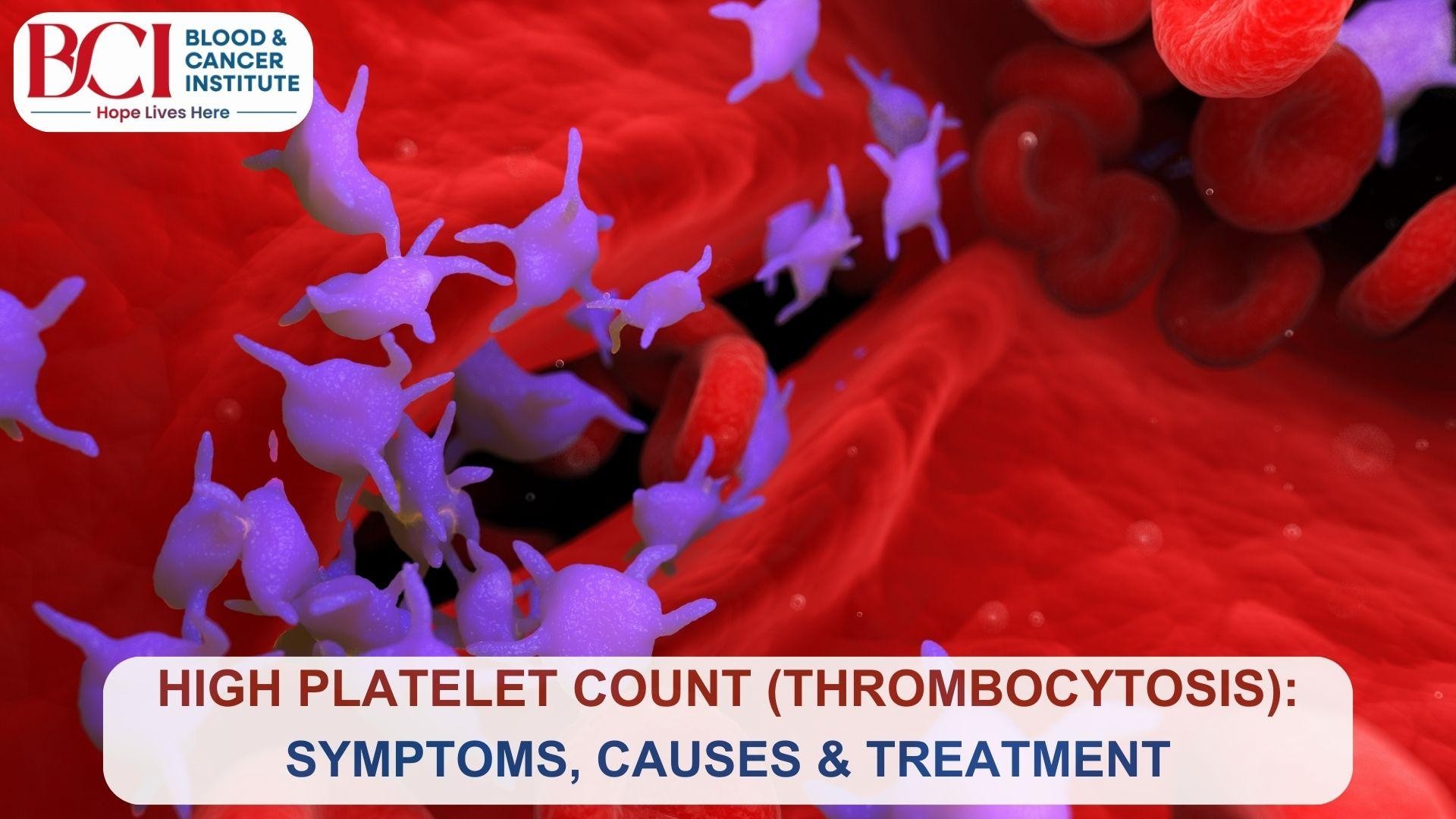
- By : BCI
- Blog
- Comments: 0
High Platelet Count (Thrombocytosis): Symptoms, Causes, and Treatment
Platelets are essential blood components responsible for clotting and wound healing. However, an abnormally high platelet count, known as thrombocytosis, can lead to severe health complications, including excessive clotting or, in some cases, bleeding disorders. While many people may have a slightly elevated platelet count without noticeable symptoms, it is important to understand the underlying causes, symptoms, and available treatments from our blood cancer specialists in Surat at BCI- Blood and Cancer Institute.
Understanding Thrombocytosis
A normal platelet count ranges between 150,000 to 450,000 platelets per microliter of blood. When the count exceeds this range, a person is diagnosed with thrombocytosis. This condition is broadly categorized into two types:
● Primary (Essential) Thrombocythemia — A disorder in which the bone marrow produces too many platelets without an identifiable cause.
● Secondary (Reactive) Thrombocytosis — A condition resulting from underlying factors such as infections, inflammation, or other medical conditions.
Symptoms of High Platelet Count
Many individuals with thrombocytosis do not experience symptoms, and the condition is often discovered incidentally during routine blood tests. However, in cases where symptoms do appear, they may include:
● Frequent headaches or dizziness
● Numbness or tingling in hands and feet
● Unexplained bruising or excessive bleeding
● Vision disturbances
● Chest pain or shortness of breath
● Blood clots in veins or arteries (deep vein thrombosis, pulmonary embolism, or stroke)
Severe complications, such as stroke or heart attack, may occur if blood clots form and block vital arteries, warn expert blood cancer specialists in Surat.
Causes of Thrombocytosis
The cause of thrombocytosis determines whether it is primary or secondary:
Primary Thrombocythemia Causes
● Genetic mutations (such as JAK2, CALR, or MPL gene mutations) that affect bone marrow cell production.
● Bone marrow disorders, including myeloproliferative neoplasms.
Secondary Thrombocytosis Causes
● Infections — Bacterial, viral, or fungal infections can trigger an increase in platelets.
● Chronic inflammatory conditions — Diseases like rheumatoid arthritis or inflammatory bowel disease can stimulate excessive platelet production.
● Iron deficiency anemia — A lack of iron in the body can lead to a compensatory increase in platelet count.
● Surgery or trauma — Recent operations, significant injuries, or post-surgical recovery may temporarily elevate platelet levels.
● Cancer — Certain types of cancer, including lung, gastrointestinal, and ovarian cancer, can lead to thrombocytosis, says our cancer specialist in Surat at BCI-Blood and Cancer Institute.
● Splenectomy (surgical removal of the spleen) — The spleen helps regulate platelets; its removal can result in higher platelet levels.
Diagnosis of Thrombocytosis
A hemato-oncologist in Surat may diagnose thrombocytosis through the following tests:
- Complete Blood Count (CBC) — Measures platelet levels.
- Blood Smear — Examines the shape and size of platelets under a microscope.
- Bone Marrow Biopsy — Determines abnormalities in platelet production.
- Genetic Testing — Checks for gene mutations linked to essential thrombocythemia.
- Additional Tests — To identify underlying conditions causing secondary thrombocytosis.
Treatment Options for High Platelet Count
Treatment depends on whether thrombocytosis is primary or secondary, as well as the patient’s overall risk of developing complications such as blood clots.
Treatment for Primary (Essential) Thrombocythemia
● Aspirin Therapy — Low-dose aspirin is often prescribed to reduce the risk of blood clots.
● Platelet-Lowering Medications — For high-risk individuals, drugs like hydroxyurea, anagrelide, or interferon-alpha may be recommended to suppress platelet production.
● Plateletpheresis — In rare cases, a procedure to remove excess platelets directly from the blood is performed in emergencies.
Treatment for Secondary (Reactive) Thrombocytosis
● Addressing the underlying cause — Managing infections, inflammation, or other medical conditions typically resolves secondary thrombocytosis.
● Iron Supplements — If caused by iron deficiency anemia, increasing iron intake can help regulate platelet levels.
● Surgery Follow-Up — If thrombocytosis occurs after spleen removal, doctors monitor the patient and recommend lifestyle adjustments as part of treatment.
Managing Thrombocytosis: Lifestyle and Prevention
While some cases of thrombocytosis cannot be prevented, healthy lifestyle choices can help minimize complications:
● Stay Hydrated — Drinking enough water improves blood circulation and prevents clotting.
● Maintain a Balanced Diet — Eating foods rich in omega-3 fatty acids (fish, flaxseeds), leafy greens, and whole grains can support heart and blood vessel health.
● Exercise Regularly — Physical activity reduces the risk of blood clots and promotes overall well-being.
● Avoid Smoking and Limit Alcohol — These habits can negatively affect blood vessel function and increase clotting risks.
● Routine Health Checkups — Regular screenings can detect abnormalities early and prevent severe complications.
Final Thoughts
Thrombocytosis may seem like a silent condition, but its potential complications can be severe. Recognizing the symptoms, understanding the causes, and seeking timely medical intervention from an experienced hematologist in Surat are key to managing a high platelet count effectively. If you or someone you know experiences symptoms associated with thrombocytosis, consulting a healthcare provider can help ensure proper diagnosis and treatment, ultimately reducing health risks and improving quality of life.
